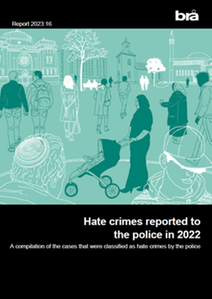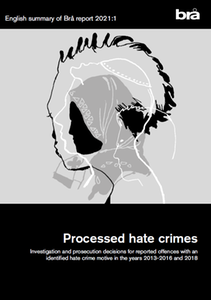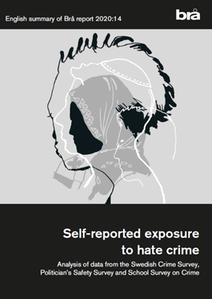- Start
- / Home
- / Crime and statistics
- / Hate crime
Hate crime
Statistics on police reports with identifed hate crime motives. Published biannualy.
About the statistics
The statistics are based on reported crimes that the police classified as hate crimes and where Brå identified hate as the underlying motive. The report is a descriptive compilation and comprises an investigation of the police’s hate crime classification, and an account of the hate crime motives Brå identified, as well as crime categories, type of crime scene, and the victim’s gender and relationship to the perpetrator. In addition to this, statistics were also reported on the regional distribution of the reported offences, i.e., divided across the police regions where they were registered, and statistics on the distribution of hate crimes per municipality, based on where the offences took place.
As of 2020, Brå’s statistics of offences reported to the police where hate was identified as the motive, constitute a comprehensive investigation of all police reports that the police classified as hate crimes. The statistics are based on a different data selection than Brå’s previous hate crime statistics, which means that the statistics in this report are not comparable with Brå’s previous hate crime statistics.1 It is important to note that the consistently lower levels of crime with hate as the underlying motive included in this report do not mean that there has been an actual reduction in the number of reported hate crimes, but that this is a consequence of a change in the selection of reports reviewed by Brå.
The changes to the selection and the method were carried out to increase the relevance of the statistics. The new statistics can be used as a more relevant basis for following up administrative decisions on reported crimes with hate as the underlying motive. The changes also make it possible to use hate crime statistics as a tool for following up operations, such as evaluating the police’s initial handling of reported offences classified as hate crimes. The statistics thus become more relevant to the police’s operational activities.
Motives for hate crime
Distribution of motives for hate crime, percentage. Source: Hate crimes reported to the police in 2022
All hate crimes
Several reports included more than one hate crime motive, resulting in a total of 2,834 identified hate crime motives. Of these, at an overall level, xenophobic and racist hate crimes were most common (53 percent), followed by hate crimes against religious groups (16 percent) and LGBTQI-related hate crimes (12 percent). Moreover, 19 percent of all hate crime motives were judged to be unspecified. In these reports, it seems that a hate crime has been committed, but it is not possible to deduce the specific motive behind the reported offence.
Molestation was the most common crime category among all hate crime motives, accounting for 24 percent of all offences with hate crime motives. Agitation against an ethnic or national group and property damage (often in the form of graffiti) were essentially on a par at 19 percent each, followed by defamation (14 percent) and unlawful threats (12 percent).
The most common crime scene in the reports was a public place (20 percent) and in or near the victim's home (17 percent). The school environment was also a relatively common crime scene, with about 15 percent of reported hate crimes occurring there. Digital environments were similarly common as a crime scene, at around 14 percent.
The statistics also report the modus operandi used in the hate crime. Verbal or other non-physical abuse was the most common modus operandi among all hate crimes (33 percent). Almost equally common was for the hate crime to involve some sort of property damage or the spreading of messages with a hate crime motive (32 percent), while physical abuse or attacks were seen in about 16 percent of the reports. Hate crimes via digital channels, such as public posts and chats, accounted for 7 percent of the reports.
The victim was a man in 37 percent of the reports and a woman in 26 percent. In 31 percent of the reports, no crime was committed against a natural person. These police reports largely concerned offences such as property damage and agitation against an ethnic or national group.
The perpetrator was a man in 46 percent of the police reports and a woman in 14 percent. However, in 36 percent of the police reports, the perpetrator's gender was unknown, which is common in different types of property damage where there are no witnesses to the incident, such as in the case of graffiti.
About one tenth (12 percent) of all police reports concerned hate crimes against a person who was working at the time of the incident.
Most common was for the perpetrator to be unknown to the victim or for the victim to know the person by name or sight only (27 percent and 9 percent, respectively). In one tenth (10 percent) of the reports, the perpetrator was a neighbour of the victim.
Xenophobic and racist hate crimes
Among the hate crime motives identified in 2022, 17 percent were Afrophobic, 1 percent antiziganistic, 1 percent hate crimes against the Sami and 35 percent were categorised as other xenophobic and racist motives. The latter category included both general and unspecified xenophobic and racist hate crime motives, as well as hate crimes aimed at specific ethnicities and nationalities that were too few in number to be reported separately.
Just as in 2020, the xenophobic and racist hate crimes had a varied crime structure. Molestation and defamation were the most common offences, although threats and violence were also relatively common. These hate crimes were most often committed in or near the victim's home or in public places, as well as in schools, on public transport and in digital environments. The victim was most often a man, most commonly subjected to some form of verbal or other non-physical abuse (such as being followed by someone). The perpetrator was often a man, in many cases unknown to the victim. However, it was almost as common for the perpetrator to be known to the victim in some way, such as a neighbour.
Among Afrophobic hate crimes, defamation was the most common offence, differing from all other hate crime motives for which molestation was more common. The crime scene was often a public place or in the school environment. It was also common to be victimised in digital environments or in the vicinity of one's home. Being victimised at school was more common in Afrophobic hate crimes than in most other motives.
Hate crimes against religious groups
Among hate crimes against religious groups, Islamophobic hate crimes were the most common (8 percent of all hate crime motives), followed by anti-Semitic (4 percent), other hate crimes against religious groups (3 percent) and Christophobic hate crimes (1 percent). The anti-Semitic hate crimes largely comprised of agitation against an ethnic or national group, which is not usually aimed at a specific individual, and was most commonly seen in digital environments as well as in public places and schools. The Islamophobic hate crimes differed from the anti-Semitic hate crimes in that they more often involved molestation, usually committed in a public place or in or near the victim's home. It was also the Islamophobic hate crimes that had the highest proportion of women among the victims, compared to all other hate crime motives.
LGBTQI-related hate crimes
The LGBTQI-related hate crimes included homophobic hate crimes (6 percent of all hate crimes), transphobic hate crimes (3 percent) and other LGBTQI-related hate crimes (3 percent). Among the LGBTQI-related hate crimes, the most common offence was molestation, although threats and violence were also seen to a slightly greater extent than among the other motive groups. Victimisation in digital environments was also relatively common, in chats, public posts and even direct messages. A large proportion of the victims were men and the perpetrator was most often unknown to the victim.
Among the transphobic hate crimes, the vast majority of the offences were committed in digital environments, which explains why the most common modus operandi was to write something offensive in a chat, instant message or public post. Unlike the other motives, there were also relatively few transphobic hate crime police reports that did not involve a natural person as the victim. In other words, a large proportion of the reported transphobic hate crimes were aimed at specific individuals.
The other LGBTQI-related hate crimes were largely comprised of various forms of property damage (often graffiti) affecting LGBTQI-related events and organisations, as well as damage to Pride flags.
Regional distribution
Of the police reports classified as hate crimes in 2022, the greatest number was registered in Police Region Stockholm (26 percent), followed by Police Region South (24 percent) and Police Region West (16 percent). However, when population size is taken into account, Police Region South had the most reports (32 per 100,000 inhabitants), followed by Police Region Stockholm (28 per 100,000 inhabitants). This was followed by Police Regions North, East and Central, all of which registered about 23 reports per 100,000 inhabitants. Xenophobic and racist hate crimes comprised the most common motive across all police regions. The largest proportion of reported offences with an identified hate crime motive took place in or near major cities and urban centres.





